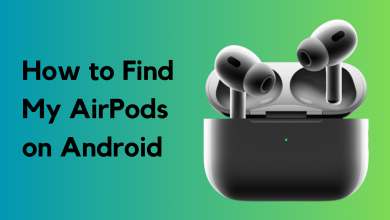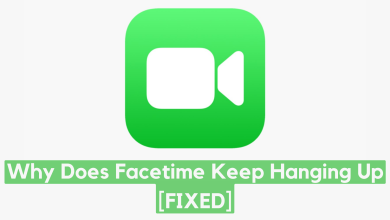HomePod Not Responding? Try These Fixes
Your HomePod might not respond mainly due to bad router configurations or outdated/corrupt HomePod firmware. The router configurations may range from the power reduction feature to a corrupt firmware of the router.

The issue arises when the HomePod stops responding to personal requests, commands from the Home app (like playing music from the Apple Music), shows not responding message in the Home app, or does not respond to the physical touch on the top of the HomePod.
Your HomePod might not respond due to many factors but the following are the most common ones:
- Outdated Firmware of the HomePod: You may encounter the HomePod issue at hand if the firmware of the HomePod is outdated as it can make the pod incompatible with the other related devices (like a router, iPhone, etc.) and that incompatibility may not let these devices properly handle the HomePod responses.
- Improper Configurations of the Router: There are many router configurations like power reduction, QoS, 5 GHz router band, etc. that can hinder the HomePod’s communication and thus cause the problem.
- Corrupt Firmware of the HomePod: If the firmware of the HomePod has gone corrupt, then that can make the HomePod unresponsive to the commands issued to it.
- Corrupt Firmware of the Router: You may face the HomePod problem under discussion if the firmware of the router has gone corrupt and as a result, the router fails to relay the data packets from the HomePod to its destination.
1. Restart the HomePod, Router, and Connected Device
A temporary communication glitch between your HomePod, router, and connected device (like an iPhone) may cause the not responding issue at hand. Here, restarting the HomePod, router, and connected device may solve the problem.
- Power off your HomePod, router, and connected device (like an iPhone).
- Now unplug the HomePod and router from the power source.

Unplug the Router from the Power Source - Then wait for a minute and afterward, plug back the power cables to both devices (HomePod and router).
- Now power on your router and once it is properly powered on, power on your connected device like an iPhone.
- Then power on your HomePod and afterward, check if the HomePod has started to respond.
- If not, relocate the HomePod where there is no electromagnetic interference (like interference from a wireless speaker) and the HomePod is in the line of sight with your router.
- Now check if the HomePod is clear of the error.
- If that fails, check if touching the top of the HomePod and speaking to Siri resolves the issue.
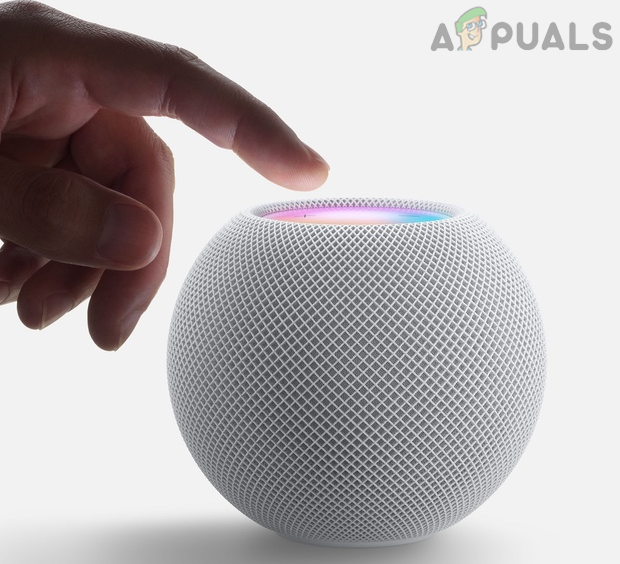
Touch the Top of the HomePod to Speak to Siri
2. Update the Firmware of HomePod to the Latest Build
The HomePod might show the no response issue if the firmware of the HomePod is outdated as it can make the HomePod incompatible with the other devices (like a router, iPhone, etc.) on the network. In this case, updating the firmware of the HomePod to the latest build may solve the problem. Please make sure to keep the HomePod plugged in during the update process (a white spinning light appears on the HomePod during the update), otherwise, you may brick it.
2.1 Update the HomePod’s Firmware Through an iPhone
- Launch the Home app on your iPhone and tap on the Home icon.
- Now open Home Settings and select Software Update.

Update the Firmware of the HomePod Through the Home App of the iPhone - Then check if a firmware update of your HomePod is available, if so, tap on Update or tap on Update All to update the firmware of all the related devices at once.
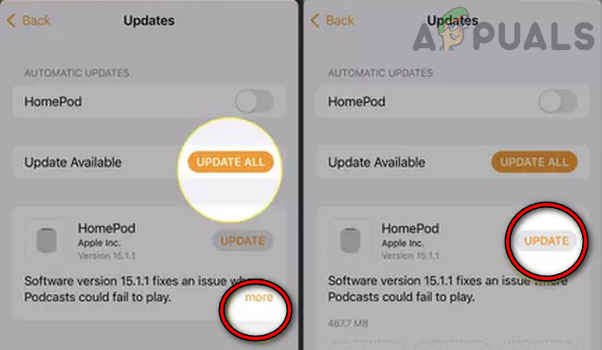
Tap on Update for the HomePod on the iPhone’s Home App - Now, wait till the update process completes, and once updated, check if the HomePod is responding normally.
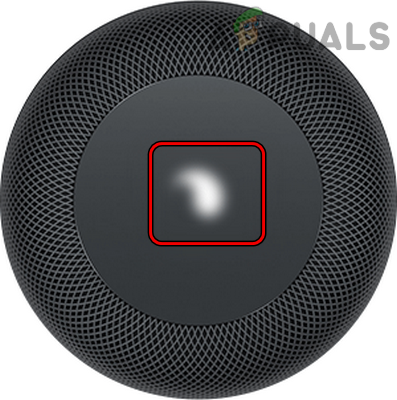
White Spinning Light on the HomePod as the Firmware Update is in Progress
2.2 Update the HomePod’s Firmware Through a Mac
- Launch the Home app on your Mac and click on the Home icon.
- Now select Home Settings and click on Software Update.
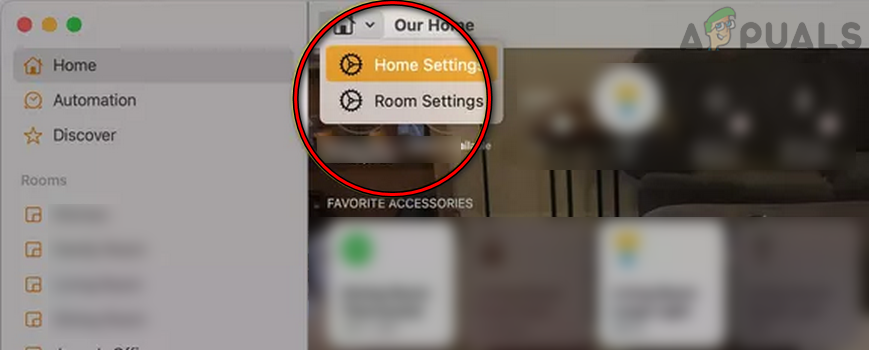
Open Home Settings in the Mac’s Home App - Then, for the problematic HomePod (if you have more than one), click on More.
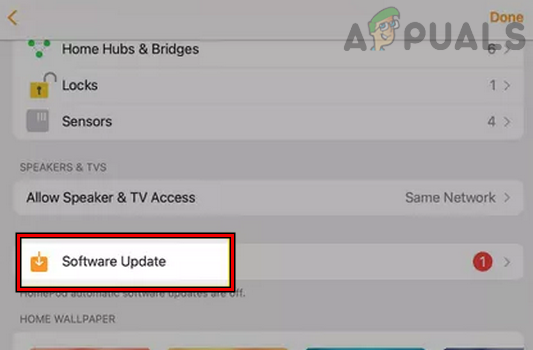
Open Software Update in the Mac’s Home App - Now click on Update to update the Homepod’s firmware or click on Update All to update the firmware of all the related devices and wait till the update process completes.
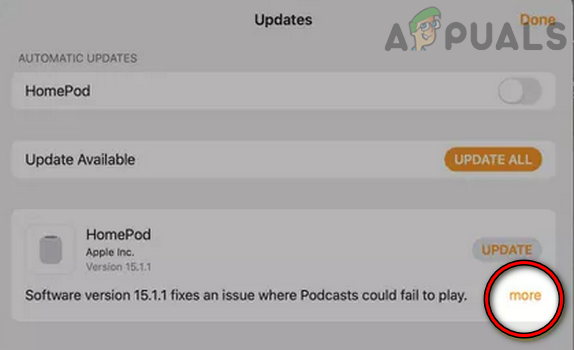
Open More in the Software Update Settings of the Mac’s Home App - Once updated, check if the HomePod’s response problem is cleared.
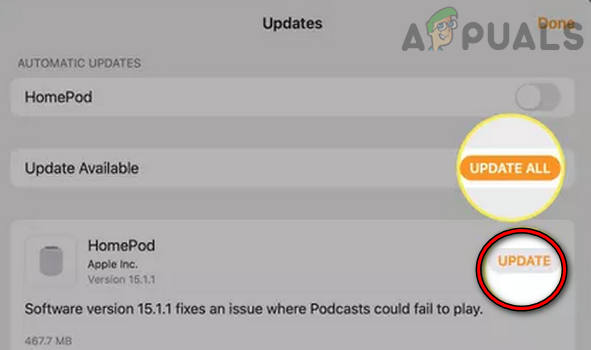
Update the HomePod’s Firmware Through the Mac’s Home App
3. Disable the Power Reduction Feature of Your Router
If your router is configured to reduce its throughput to save the power consumed by the router if there is limited or no traffic, then that may make your HomePod not respond as the router hinders the data exchange between your device (like an iPhone) and HomePod. Here, disabling the power reduction feature of your router may clear the issue.
- Launch a web browser and head to the router’s management portal.
- Now log in using your credentials and in the left pane, head to the Home Network tab.
- Then steer to the sub-tab of Interfaces and in the right pane, open WLAN.
- Now select your Wi-Fi network and expand its Configuration section.
- Then untick the option of Power Reduction Enabled and apply your changes.

Untick Power Reduction Enabled in the Router’s Settings - Now restart your devices (HomePod, router, and connected device) and check if the HomePod is clear of the issue upon restart.
4. Disable the 5 GHz Band of the Router
You may encounter the HomePod not responding issue if the HomePod is having compatibility issues with the 5 GHz band as HomePods have a reported history of having issues with the 5 GHz bands on different routers. In this scenario, disabling the 5 GHz band of your router may resolve the HomePod issue.
- Launch a web browser and steer to the router’s web portal. Afterward, log into the portal by using your credentials.
- Then expand its Settings tab and head to the sub-tab of Wireless.
- Now, in the General section, deselect 5 GHz by unticking its checkbox and enable the 4 GHz option by ticking its checkbox.

Disable 5GHz Band in the Router’s Settings - Now save the changes made and then restart your
- Upon restart, check if connecting the HomePod (you may have to reset it) and iPhone or Mac to the 2.4 GHz network solves the problem.
5. Disable QoS and UDP/Multicast Traffic
Your router’s QoS (Quality of service) feature manages the network traffic to reduce jitter/latency or packet loss by prioritizing particular data types on your network. The problematic HomePod might show the error at hand if your router’s QoS feature is prioritizing other traffic over HomePod’s data packets and causing a latency during the real-time communication. In such a case, disabling your router’s QoS feature may resolve the issue.
- Launch a web browser and head to your router’s management page.
- Now log in by using your credentials and switch to the Advanced tab.
- Then, in the left pane, expand the Setup tab and steer to the sub-tab of QoS Setup.
- Now, in the right pane, untick the checkbox of the Turn Internet Access QoS On.

Disable QoS in the Router’s Settings - Then click on Apply and afterward, check if the HomePod is operating normally.
- If not, check if disabling UDP or Multicast in the router settings resolves the issue.
- If the issue persists, check if setting up DHCP (if the router is being used in AP mode) on your wireless router clears the error.
6. Re-Log into the HomePod
If the Apple servers are having issues in authenticating the HomePod against your Apple ID, then that may make the HomePod not respond as the servers may actively refuse the requests by the HomePod (like trying to play music from Apple Music). In this scenario, logging out and logging back into the HomePod may solve the problem.
- Launch the Home app and tap/hold on the HomePod.
- Now open Settings by tapping on the gear icon and scroll to the primary user.
- Then select your Apple ID and tap on Sign Out.
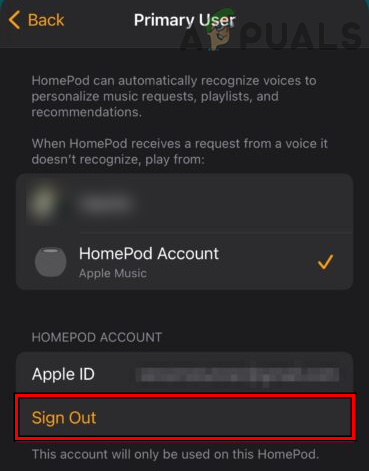
Sign Out of the HomePod - Now confirm to Sign Out of the Apple ID and power cycle the HomePod.
- Then set up the HomePod again to check if it has started to respond normally.
- If not and you have more than one HomePod, sign out of all the HomePods.
- Then power cycle the HomePods and router.
- Now re-log into the HomePods and check if that resolves the issue.
7. Disable/Enable Personal Requests in the Home App
A temporary glitch may not let the Siri commands (aka personal requests) reach or execute on the HomePod and disabling/enabling personal requests in the Home app may solve the problem.
- Launch the Home app and open Home Settings.
- Now tap on your name and select Personal Requests.
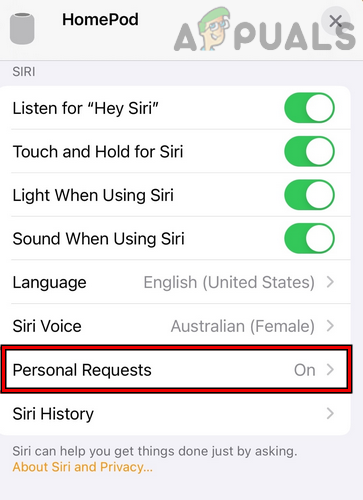
Open Personal Requests in the HomePod’s Settings - Then disable Personal Requests by toggling its switch to the off position and afterward, enable Personal Requests to check if that resolves the issue.

Disable Personal Requests in the HomePod Settings - If not, check if enabling the Find My iPhone setting resolves the HomePod issue.
8. Remove and Re-Add Your HomePod to the Home App
A temporary communication glitch between your device (like an iPhone or Mac) and HomePod might cause the non-responsiveness of the HomePod. In this context, removing and re-adding the HomePod to the Home app may solve the problem.
8.1 On an iPhone
- Launch the Home app on your iPhone and tap/hold the problematic HomePod.
- Now scroll down and tap on Reset HomePod.
- Then press the Remove Accessory button and afterward, re-add the HomePod to the Home app.

Remove HomePod Accessory from the HomeApp - Now check if the HomePod is working normally.
8.2 On a Mac
- Launch the Home app on your Mac and double-click on the problematic HomePod.
- Now scroll down and click on Reset HomePod.
- Then click on Remove Accessory and re-add the HomePod to the Home app to check if it has started to work fine.

Remove the HomePod Accessory in the Mac’s Home App
9. Hard Reset the HomePod to the Factory Defaults
You may encounter the issue at hand if the firmware of the HomePod is corrupt and the HomePod is failing to respond to the requests from you or your device. In such a case, hard resetting your HomePod to the Factory Defaults may solve the problem.
- Unplug the HomePod from the power source and wait for 10 seconds.
- Now plug back the HomePod to the power source and wait for 5 seconds.
- Then touch and hold your finger to the top of the HomePod.
- Now the white spinning light of the HomePod will become red but keep on holding your finger down.
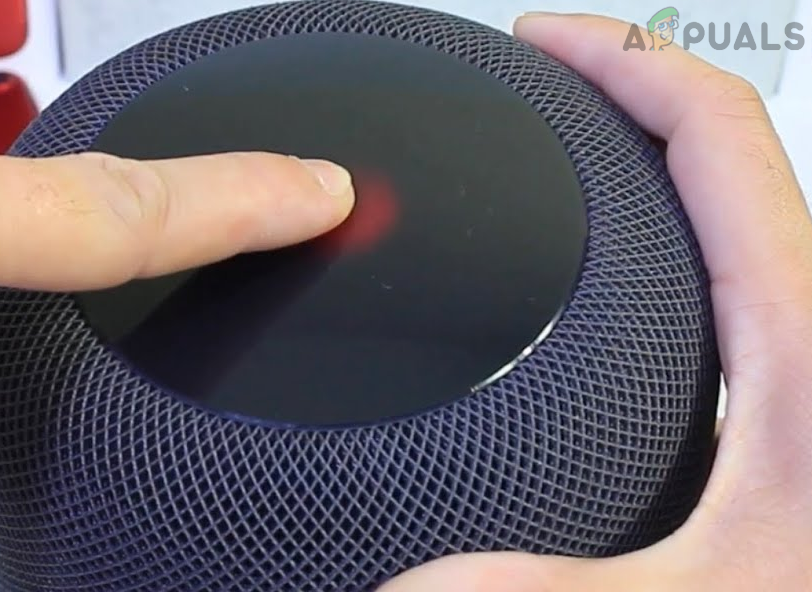
Press the top of the HomePod to Hard Reset it - Then Siri will prompt that the HomePod is about to reset and will start beeping.
- After the third beep, lift your finger from the HomePod and once the process is done, set up the HomePod to check if it is working fine.
- If that fails, unplug the HomePod from the power source and wait for 24 hours.
- Then check if again hard resetting the HomePod to the factory defaults solves the problem.
10. Remove the HomePod from Your iCloud Account
If the HomePod was added to your iCloud account but is not removed after factory resetting the HomePod, then the iCloud’s syncing mechanism may cause the duplication in the Home app and thus cause non-responsiveness of the HomePod in the Home app. Here, removing the HomePod from the iCloud account and then resetting it may solve the problem.
- Launch a web browser and head to the iCloud website.
- Now open its Settings and check if the HomePod is shown there.
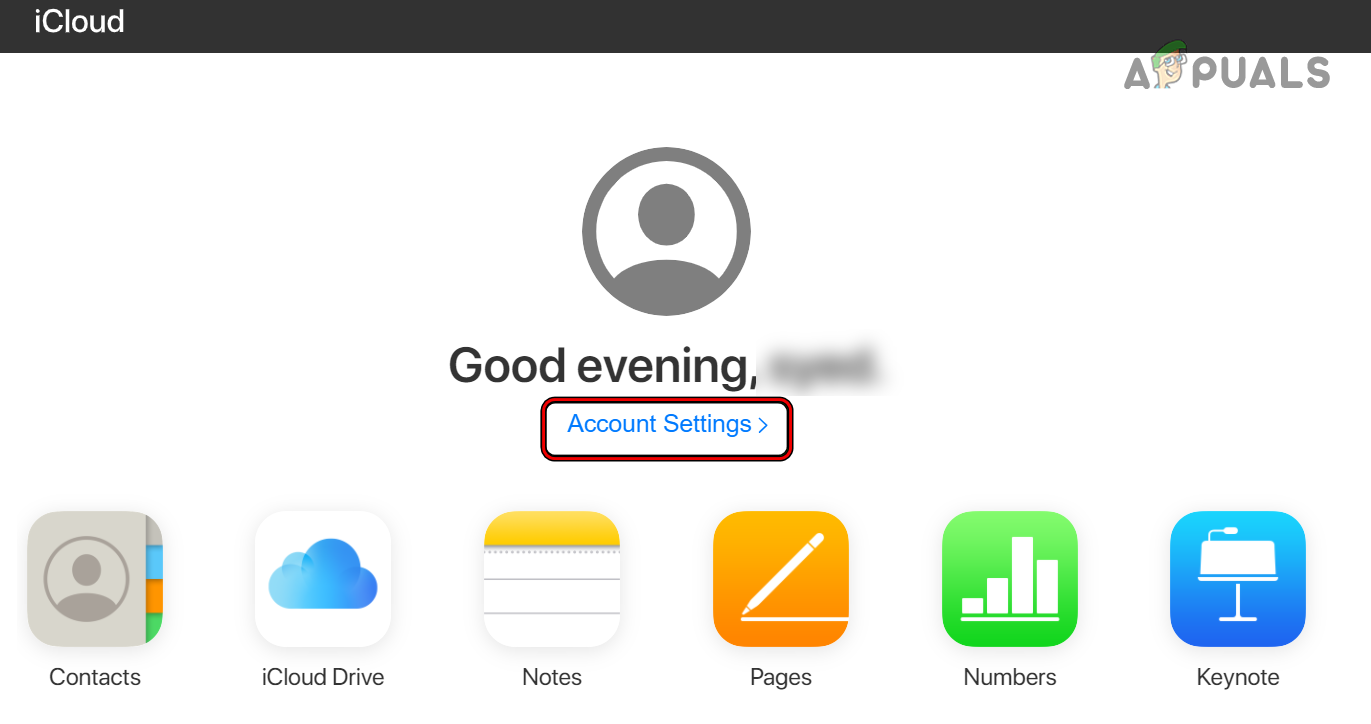
Open Account Settings of iCloud - If so, then click on the HomePod and select Remove.
- Then confirm to remove the HomePod from the iCloud and afterward, reset the HomePod (as discussed earlier).
- Now set up the HomePod again and check if it is clear of the problem at hand.
11. Reset Your Router to the Factory Defaults
The HomePod may fail to respond if the firmware of your router is corrupt and resetting your router to the factory defaults may clear the HomePod issue. Before moving on, make sure to note down the information required to re-setup the router after resetting it.
- Firstly, locate the router’s reset button (on the back or bottom of the router), and once located, press/hold the reset button of the router (you may have to use an object like a paperclip).
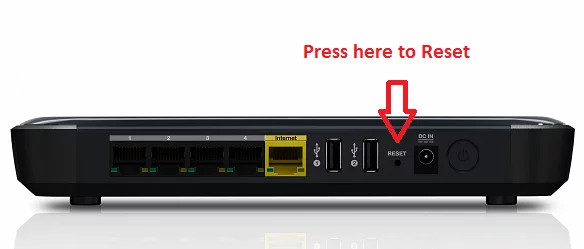
Reset Your Router to the Factory Defaults - Now, wait for 30 seconds and then release the reset button.
- Then wait till the router properly powers on and afterward, set it up as per your ISP guidelines. Do not connect any other device to the router yet, so, the HomePods should be the first device connected to the new Wi-Fi network.
- Now reset your HomePods as well (discussed earlier).
- Then re-setup the HomePods and hopefully, the HomePods will be working fine.
If not, check if using another router or temporarily connecting your devices to a phone’s hotspot resolves the issue. If so, then the incompatible router (many of the older routers are reported to cause the issue) is the root cause of the problem and you may need to replace your router.
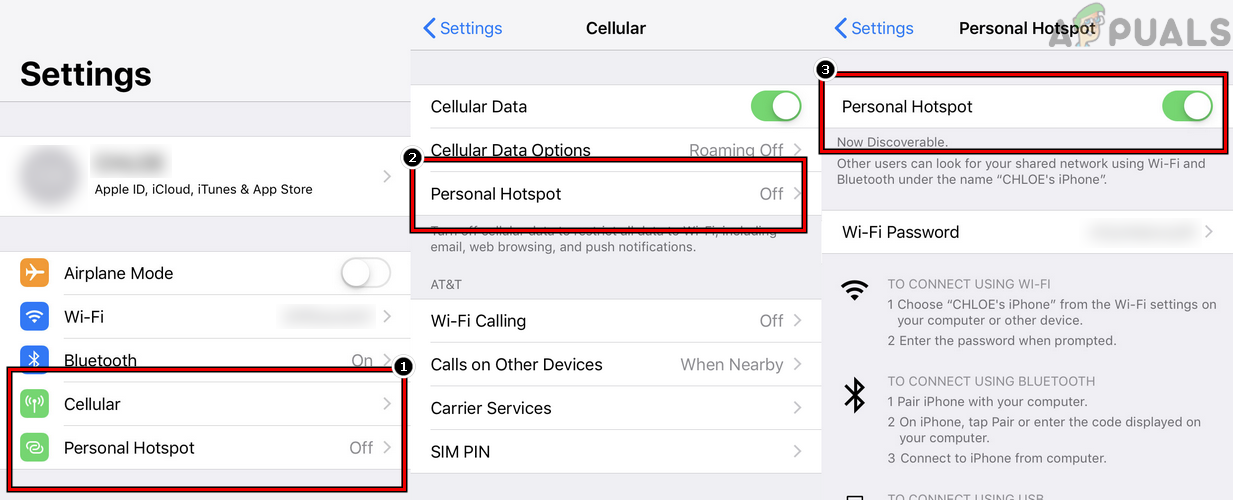
If that did not work, then you may get your HomePod checked for a hardware error and try to get it replaced, if under warranty.

